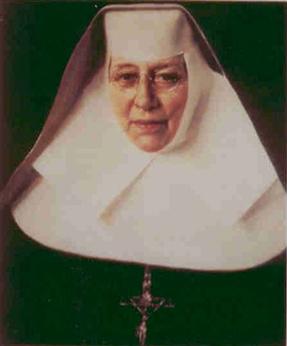Mother Katharine Mary Drexel (1858 – 1955) is a fitting intercessor for the racial tensions afflicting her native United States – she is the first natural born canonized American citizen (Elizabeth Ann Seton was born in 1774, in what would become that nation a few years later). A young debutante who inherited her father’s fortune (about $7 million back then, worth many times that in today’s deflated dollars), she could have ‘had it all’. Her birth mother had died five days after Katherine’s birth, and her father re-married well, to Emma Bouvier, who gave her stepchildren – Katherine and her two sisters. Emma was a fine example of holiness, caring for the poor, and even seeking out those too ashamed to come to the door: As the new Mrs. Drexel was to say, Kindness may be unkind if it leaves a sting behind, words which all of us could take to heart.
As she pondered her vocation, Katharine was struck by the transitory nature of the world, as cancer slowly took the life of her new mother, and, with the death of her father in 1885, Katharine, who had always been devoted to helping Native Americans, empathizing with their plight, decided to enter a convent, and consecrate her life, and her fortune, to God, in helping the poor and disadvantaged. The final straw that moved her in this direction was a private meeting with Pope Leo XIII that evokes that of her near-contemporary, Therese of Lisieux. When Katherine asked the Pope for missionaries to help in their work, the Holy Father replied, ‘Why don’t you become one?’.
And so, she did, taking her first vows on February 12th, 1891 as a Sister of Mercy. Her long life was filled with setting up schools – 62 in all (!) – and missions – 145 of them (!), all of which did yeomen’s – or yeowomen’s – work for the kingdom.
Mother Katharine died on this day, March 3rd, in 1955, at the noble age of 96. Good thing, we might think, that she did not live to see the tragic collapse of religious life a decade or so later. (Sadly, as a sign of our secular times and dwindling religious vocations, Katharine’s shrine closed in 2017, the convent and grounds put up for sale, and her remains transferred to the Cathedral of Saints Peter and Paul in Philadelphia). Or, perhaps, she did see, but from the safe, beatific vistas of heaven. She was canonized on the feast of the Little Flower, appropriately enough, October 1st, in the Jubilee year 2000, by fellow Saint John Paul II.
Saint Katharine leaves an outstanding, heroic legacy and example, using her many talents well, producing ten-fold more. May she intercede for the United States, that sanity and even sanctity return to a land now ravaged by the sad lack of both.
Saint Katharine Drexel, ora pro nobis!

